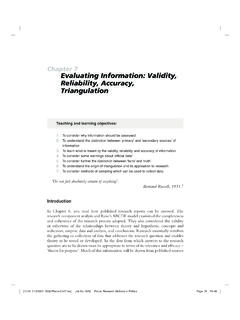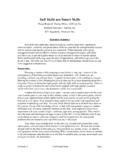Transcription of Diagnostic Process- Chapter 5 - brkhealthcare
1 Diagnostic process - Chapter 5 Chapter 5 Objectives Identify system paramour and recognize the symptoms, problems, and cause of the organizational ineffectiveness Recognize the various techniques for gathering information from the client systems Describe the major various techniques use in OD programs Apply a systematic diagnosis to organizational situationDiagnosing Problem Areas The identification of areas for improvement and problems is an important element in developing a high performance organization. Before implementing an OD program, it is important to assess the organization s current quality or performance and define the level of performance or quality it desires.
2 Diagnosis provides information that allows a faster-reacting organization to emerge. Diagnosis rigorously analyses the data on the structure, administration, interaction, procedures, interfaces, and other essential elements of the client system. Effective change must be based on a specific diagnosis of the is a Diagnosis Diagnosis is a systematic approach to understanding and describing the present state of the organization. The purpose is to specify the nature of the problem requiring solution to identify the underlying the forces, and to provide a basis for selective effective change strategies techniques.
3 Diagnosis involves the systematic analysis of data regarding the organization structure and culture with the intention of discovering problems and areas for is Diagnosis Critical Issues in Diagnosis Simplicity Visibility Involvement Primary Factors Measure What s Important Sense of UrgencyThe process Diagnosis is a cyclical process involving gathering interpretation, identification of problem areas, and potential action program, Steps Step 1- Tentative problems and identified Step 2 Collect data Step 3 Analyze data Step 4 Feedback data Step 5 Is more data needed Step 6 Problems areas are identified Step 7- Is the client motivated to work on the problem Step 8 Diagnosis and work on the problem Step 9 Monitor and assess resultThe Performance Gap The difference between what the organization could do and what the organization is actually doing.
4 Self-assessment gaps of actually four key areas: Organization s strengths What can be done to take advantage of strengths Organizational weaknesses What can be done to alleviate Data Collection process OD is a data-based change activity Data is an aggregation of all signs, signals, clues, facts, statistics, opinions, assumptions, and speculations, including items that are accurate and inaccurate, relevant and irrelevant. Information is data that have form and Data Collection process Definition of Objectives Selection of Factors Selection of data-gathering method.
5 The Selection of Key Factors Identify the central variable involved in the situation. May be necessary to increase the range of depth of data beyond what is readily Data Collection process The Selection of data-gathering method Because there is no one best method, a variety of methods may be used. The nature of the problem helps to determine the Data Collection process Types of methods Secondary sources Organizational and industry data already available Employee surveys or questionnaires( useful when large number of people are involved but the data may lack richness.)
6 Other types of instrument Sociogram is a visual method or recording and analyzing the choice of preferences within a group. Thematic apperception test (TAT), and collages Direct Observation InterviewsThe Data Collection ProcessSociogram Each member of group presented in a circle. Communication between individuals is represented by arrows indicating the direction of choice. Stars- the highly chosen individuals Isolates those with few or no choices Mutual choice- certain individuals who choose one another. One-way choice when three or more persons within a large group select one another (mutual choices).
7 The Data Collection process Direct Observation Observing how people go about their task, norms, behaviors May use a sociogram to record observation. Interviews Is one of the most widely use methods of gathering data It is direct, personal and flexible Directed interview Open-ended questions Nondirected interviewThe Implementation process Decide from who the data will be obtained Select an appropriate techniques to gather data Implement data collection program. The analysis of the data Guidelines for evaluating the effectiveness of data collection Validity of the data The time to collect the data The cost of data collection The organization culture and norms The Hawthorne effect of data collectingDiagnostic Models In a study of OD practitioners, 70 % reported using a model to assist identifying problems.
8 Diagnostic models may used to analyze the structure, culture, and behavior of the Analytical Model Used for interdepartmental issues Examines four characteristics of departments Degree of department structure Time orientation of members toward others Interpersonal member s orientation toward goals The model s objective is to help departments achieve Emergent-Group Behavior Model Used to analyze interdependence of groups Collects data on activities, interactions, sentiments, and norms of groups in order to diagnosis Management Practice Model Six Basic Factors Basic planning General Business practices Finance Advertising and promotion Market research Personal Asking a few basic questions in each area, it is possible to get an indication of where the client s problems may be Sociotechnical System Model Two systems contained in each organization: Social system, which consists of interpersonal relationships.
9 Technical system, which consists of task, tools, and activities of organization. The systems are interrelated. The diagnosis determines how the systems are interrelated and what types of feedback is required between the Cause of Maps and Social Network Analysis Model Cause maps- mathematical representations of relationships among variables. Social network analysis mathematical representation of relations, both individual and group. Analysis reveals important Force Field- Analysis Model Organizational behavioral is a balance between forces working in opposite directions.
10 Restraining forces act to keep organization stable. Driving forces act to change organization. When two forces are equal, the organization is in quasi-stationary state of equilibrium. Analysis of forces determines which force to increase or decrease to bring about Flags in Diagnosis Confidentiality of the data in paramount The overdiagnosis The diagnosis drags on and many problems are identified that the diagnosis becomes a ritual of continual analysis. The crisis diagnosis Attending only to the immediate, short term crisis. Important but less visible problems are Flags in Diagnosis The threatening or overwhelming diagnosis The client is confronted by problems to the extent that the relationship with the practitioner is damaged.






